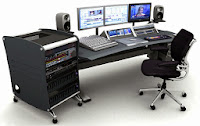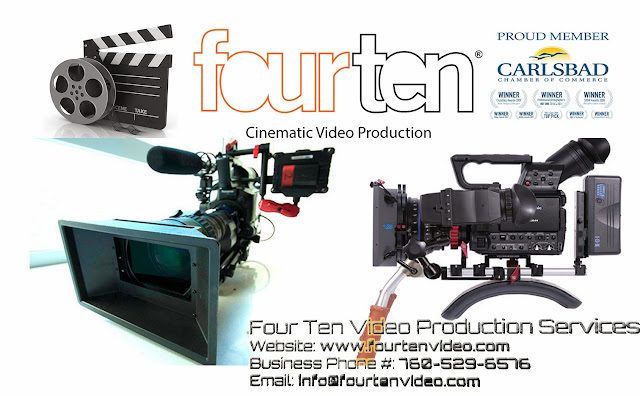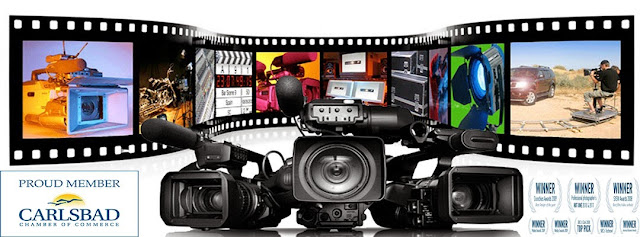The Video Production Process
THE
VIDEO PRODUCTION PROCESS FROM START TO END
We wanted to make a page designed to inform clients or just general people who would like to know more about what really goes into making a Video and a
Full Video Production. Whether its a web video, TV commercial or longer informercial style...the process is generally the same. We are a Video production Company Based in the Carlsbad and San Diego California area, so we are right at the heart of the industry's most talented teams.
We hope this will help anyone who would like to understand more about what
video production companies actually do.
You need a video commercial or TV program but you don't want something amateurish. You know you need a
professional video product, but the complex video production process and all the technology that is involved can seem overwhelming or even intimidating. Where do you start and what do you watch out for?
At Fourten Digital Media Cinematic
Video production company in San Diego, we deal with all the steps of production from start to finish, and I thought it might be helpful to outline these steps and talk about them just a bit. That way, you can become familiar with them and know what to watch for and ask for from your video professional. Just be sure your person or crew ARE professionals!
Your project may require all these steps, or only one or two of them. This shows the entire process, parts of which may be already created or not necessary for various reasons.
Here’s the order in which production things generally occur:
1. Concepting
2. Scriptwriting
3. Production Planning (Pre-production)
4.
Videography (Shoot)5. Graphics Design & Creation
6. Voice Talent Recording
7. Original Music or Library Music tracks
8.
Video Editing9. Motion Graphics & Special Effects
10. Animation
11. Final Edit, Mix, and Master
12. Dubs (Copies) or other Distribution
That's a lot of stuff, and it takes a long article (actually, two!) to explain each step of the process, but this is what WE do as your video professionals. Our goal is to make this process as easy, enjoyable, and fruitful for you as possible, regardless of your level of knowledge about production.
CONCEPTING
When you hire a video service crew, they should ask a lot of questions. They will be discovering where the starting point of this production is and what your goals and budget are for it.
You may already have an idea or concept for your spot, program, or other production. It may be solid and developed, or it may just be a rough idea. You may have no concept at all, yet.
In any case, they can help you develop a concept from scratch, flesh a rough idea into a practical approach, or take your solid approach and move on into the next phase of production.
SCRIPTWRITING
The same flexibility applies to the script. If you have a script, we can proceed into production. Most professionals can write a script for you or advise you about an existing script that may need work. Scripts for television commercials, in particular, can be tricky and there is a fine art to making them work within the typical thirty second time frame.
The script forms the backbone of the production and becomes the official reference for all that follows.
PRE-PRODUCTION (PRODUCTION PLANNING)The pre-production meeting is very important to this process. This is where specific production approaches are discussed and decided on, along with determining what resources (shoots, talent, animations, etc.) are going to be needed.
Pre-production meetings should not have a charge or fee. This should be a no-pressure, open, brain-storming event. Ideas can be shared and critiqued without consequence, and decisions about budget and approach can be locked in.
VIDEOGRAPHY (SHOOT)A camera shoot may or may not be necessary for a specific project, or you may already have “raw footage” on tape or disc, ready to be edited. Keep in mind that consumer grade video is usually not high enough quality for most broadcast products.
If a shoot is necessary either on a location or in a studio, be sure to hire a highly experienced crew that has professional camera and lighting equipment and who know how to use it.
GRAPHICS DESIGN & CREATION
Almost every production will need a graphic look or design along with various graphic elements like a company logo or art elements to coordinate with other media. Much of this may already exist, but certain graphics will probably need to be designed and created for use in post-production.
This step is often underestimated in terms of the time it takes to do and the importance of it in the final product. Graphics and a specific graphic look or identity can have a huge impact on the final video. It gives it an emotional feel and a psychological branding for the message or the product.
VOICE TALENT RECORDING
Your project may need a voice talent (or more than one). Finding the right talent can be tricky for low budget productions, as standard union rates for one talent can easily exceed the entire budget of a low dollar commercial production.
Check with your provider to see if they offer in-house talent and access to other talent resources that can be cleared for your production without residuals or high union-based fees.
ORIGINAL MUSIC or LIBRARY MUSIC TRACKS
There is almost never a production where music should not be used. Music is a fundamental element that provides an emotional identity and an emotional impact to your production. The choice of a particular music track, then, is very important to most productions.
There are two approaches to acquiring production music. The ideal way is to have an original track created for or scored to your video. A custom track will literally be made to work and fit your specific production. This can be prohibitively expensive unless the company you work with offers in-house virtual instrument music production, and a composer who knows production.
If you decide not to use a custom track, the next step is to turn to “library music” tracks, which are rights-cleared and produced for production. This was once a second-rate quality solution, but today’s top libraries are wonderfully produced and vast in scope. Often, name-famous performers and composers are contracted to create various collections of music – music that you can use in your production, available in any imaginable style.
VIDEO EDITINGThe heart of video post production is editing. Generally speaking, “post production” is anything after the shoot and voice recording sessions. All the elements have been acquired, and now the puzzle must be assembled. Unlike a pre-set puzzle, though, this one is always freeform and requires an artist to bring the various elements together in a way that not only works logically and emotionally, but also serves to deliver your important message in the most efficient way.
Editing is much more than just sticking bits of video and audio together in a line. A great editor can bring footage to life in a manner that an average competent editor just cannot do. This is because editing is an intuitive art form that has to be learned over years of handling footage and making the right decisions by learning from past mistakes. An artful, excellent edit can bring average or even sub-par raw footage to life and rescue an otherwise dull program.
The first stage of the edit process will be for the editor to go through the various raw footage sources and “digitize” them into the computer memory, making them available as virtual “clips” to choose from. Then, an initial or rough edit will be made with just the raw video set against the voice track and music. This is important because the audio establishes the timing of everything and many video edit decisions are based closely on the audio elements.
Once done, this initial edit will be taken into another stage where graphics, special effects, and other design elements are added.
MOTION GRAPHICS & SPECIAL EFFECTSA wonderful edit is magic in and of itself, but It is in this next stage of post production where a more obvious and exciting kind of magic happens.
Motion Graphics – In modern video production, almost everything moves and develops visually throughout a spot or program. Logos fly and morph into other graphics, video appears in windows that superimpose over other backgrounds, and colorful borders and shapes make an emotional impact and catch the viewer’s eye and hold their attention. Even the simple “name matte” in the lower screen over a speaker is rarely static text, but is animated, glowing, and evolving in and out of existence.
This technique and approach is generically referred to as “motion graphics” and this is what makes today’s television “look” have that polished, animated, and interesting feel. Without it, a production looks boring and “amateur” – exhibiting the dreaded “Cheap Local Look.”
As an artist, I love to put the graphic “polish” on a spot or program, and sometimes the graphics are the only elements we have to work with. Many excellent spots and programs or segments of them have no actual video resources, but are graphics, photos, or other design elements ONLY. These are presented in an animated and interesting manner using the techniques of motion graphics!
Special Effects – Motion graphics are a special effect, of course, but here we refer specifically to what most people think of by that term – special visual effects like explosions, keys and mattes (like green-screen shoots of people that are superimposed over other backgrounds), star trails, smoke, glints and gleams off objects or logos, image tiling, morphing and bending of objects, and so on.
The possibilities are truly endless, and many will be surprised to learn that the effects that can be achieved at a single computer, boutique level are every bit equivalent to Hollywood feature films, and often are used for such films. That means that you can have an effect that is truly Hollywood quality without that big L.A. price tag.
One important note about motion graphics and especially special effects. It is the sign of an artful and experienced editor or digital artist that he or she is reserved in the use of effects. "Effects for effects sake" can ruin a project and place it immediately in the “amateur” category for viewers because the effects distract from the message. That said, a judicious and artistic use of just the right effects can bring an otherwise plain piece to life and propel the viewer’s interest and involvement with your program or spot.
Once the effects and motion graphics are added to the base video edit, the combination of it all is “rendered” into a separate piece of video (a movie file) and is sent back to the edit system for finalizing and mastering.
ANIMATION
A word here about the most special of special effects. Animation can be an effective technique for many productions, but it is a complex area that can be time consuming and therefore expensive.
Animation is a broad term, however, and there are some techniques that are quite fast and easy to accomplish. Don’t dismiss animation as an option just because it sounds expensive or intimidating. Have your production experts advise you on the different approaches and help you decide if animation is practical or if it is right for your project. Animation is generally broken down into two major areas: 2D and 3D.
2D flat style drawings, like classic cartoons, are rarely done manually these days, but are accomplished with the help of the computer. This makes things much easier and faster. Flat style imagery can be very effective and less expensive to accomplish. Sometimes, just an animated graphic element is all that is needed (perhaps a gas pump with a moving meter or a face that smiles).
True 3D animation is more complex. Character animation is the most complicated to achieve, as characters must be designed, structurally boned, skinned with textures, and animated as a collection of joined parts, often into a separately designed background world. While time consuming and expensive, this also can give a production a totally unique look and identity. At my company, we have accomplished several 3D character animation projects using Lightwave3D software, the same program used to create animation elements for such features as Star Trek and Men In Black.
Some 3D animation elements are easier and more often employed, such as dimensional flying logos or other text elements. These can be very effective in either a complex or straightforward production.
FINAL EDIT, MIX, and MASTER
The movie of the final render (base edit with any motion graphics and special effects) is taken back to the edit system and a final version of the spot or program is made, adding any last minute graphics or audio elements. It is optimized for technical levels and standards, and it is given any slate ID’s needed for the final mastering process.
A final audio mix is done, as needed, to make sure the program is complete in every detail. The last production stage is to make the final “Master” of the program onto any of a variety of formats, either videotape or digital files, depending on the intended destination.
DUBS (COPIES) or other DISTRIBUTION
Copies or dubs are often needed for distribution to television stations, directly to clients, or other end-users. These can be in any of a variety of formats and media, from BetaSP (for broadcast), DVCam, MiniDV, DVD’s, or any of a wide selection of digital file formats, including formats for the Web.
Well, that seems like a lot, and it is, but a professional team's goal is to make this production process as easy and worry-free for you as possible. At my company, we’ve been doing this for so long, that this long list is truly second-nature to us!
The only thing we will rely on you, our client, for is comprehensive input and involvement at the beginning of the process, where the decisions are being made on approach, budget, and content. Once that is settled, we can basically take it from there. You will always be a part of the process along the way, with feedback and examples where needed, and your satisfaction is always the final goal.
I hope this outline has been informative and helpful. I am always available if you need further information or have questions.




















